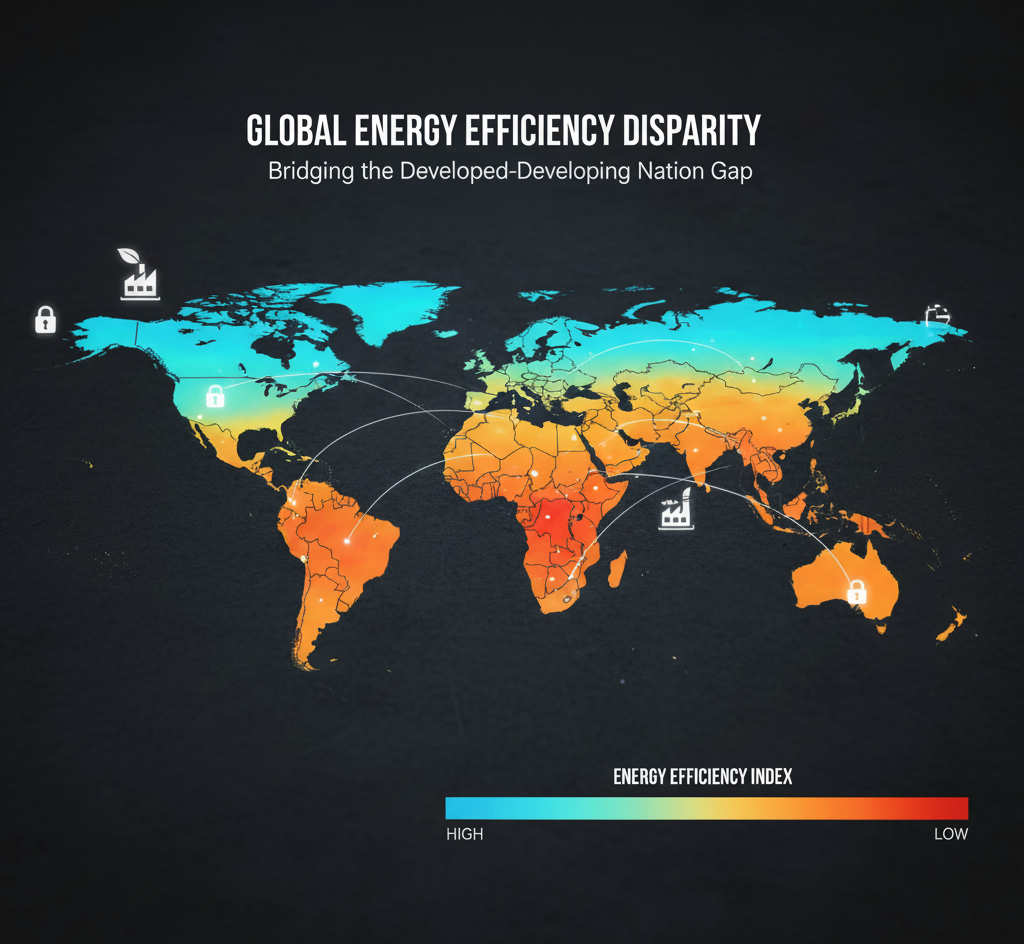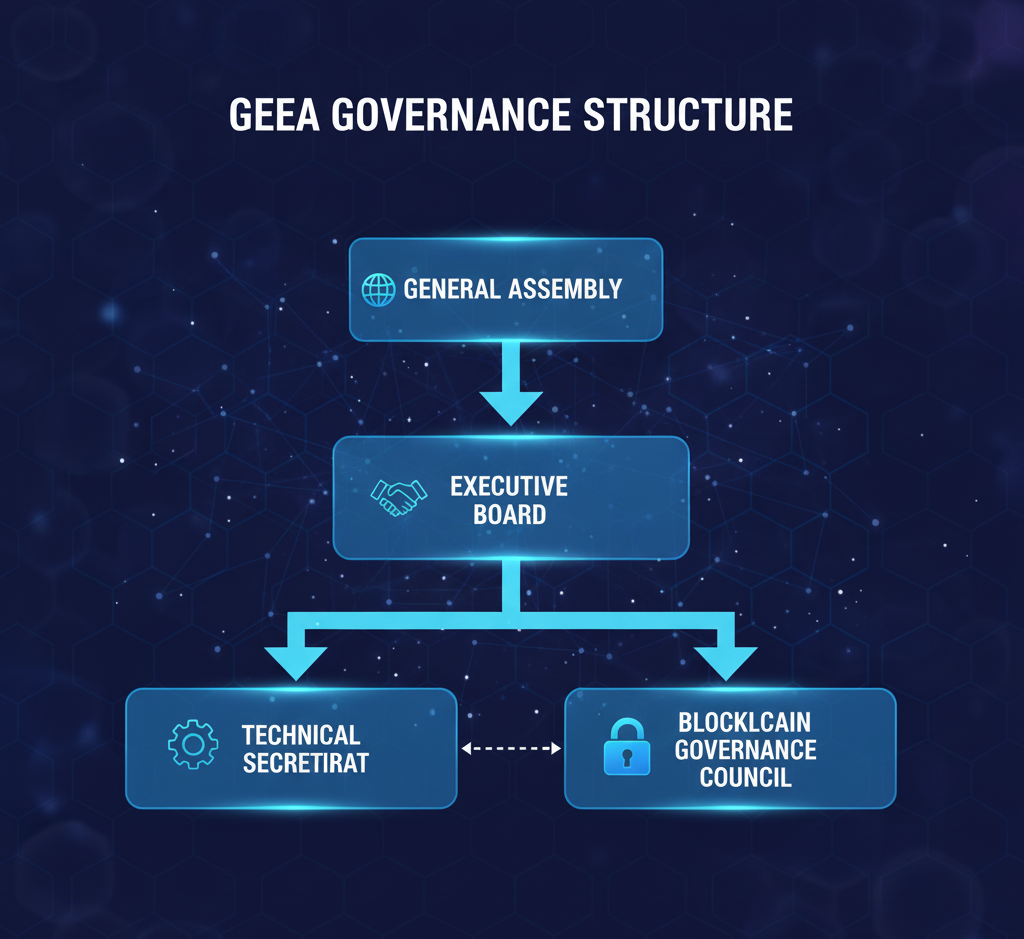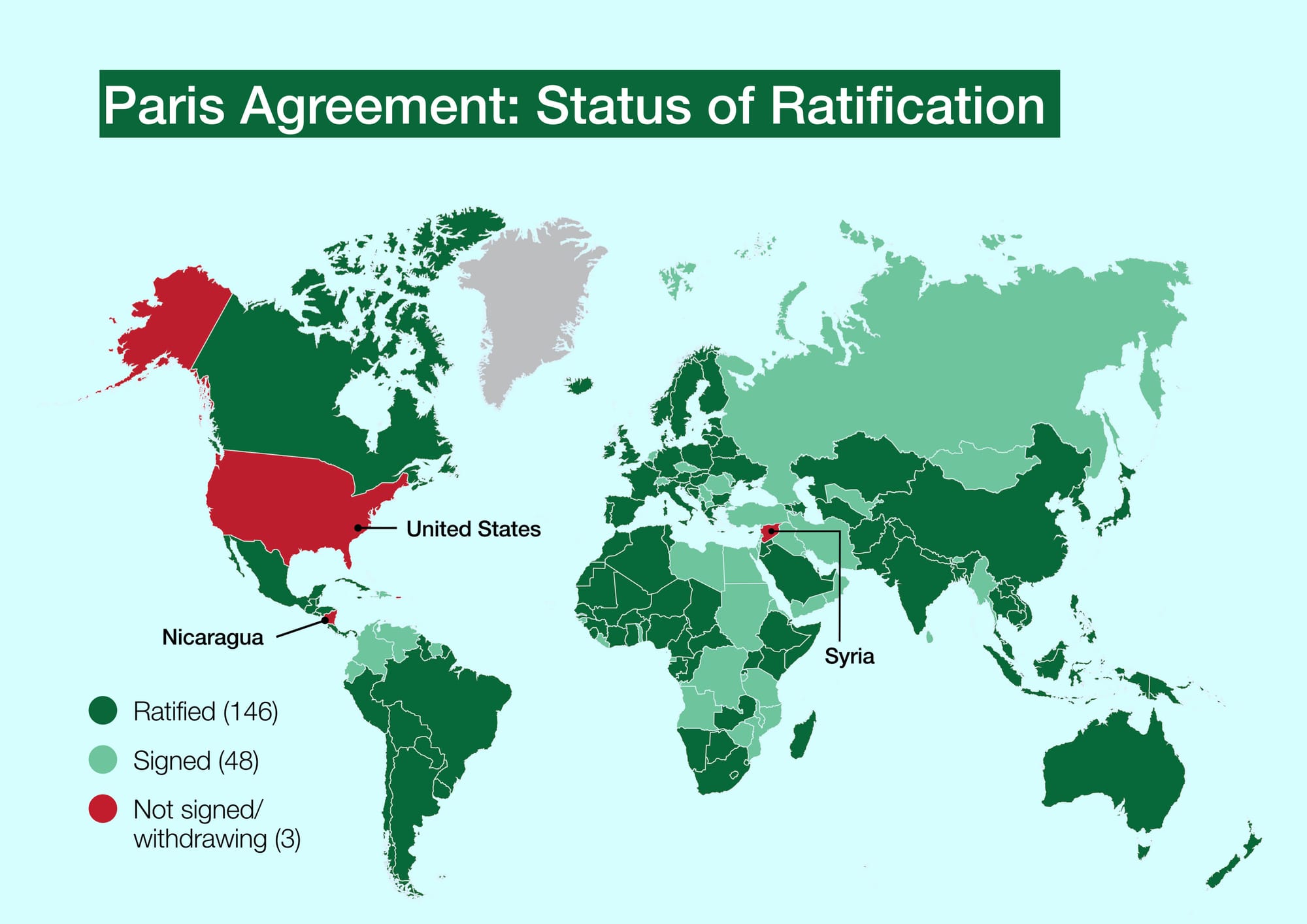The Coordination Crisis: Why Energy Efficiency Governance Is Failing
The global energy efficiency improvement rate stagnated at merely 1% in 2024, representing half the average progress achieved during the previous decade Executive summary – Energy Efficiency 2024 – Analysis - IEA. This alarming deceleration occurs precisely when accelerated action becomes existentially necessary. Despite intensified climate diplomacy since the Paris Agreement, atmospheric carbon dioxide concentrations continue rising, heating Earth at an alarming rate Global Climate Agreements: Successes and Failures | Council on Foreign Relations.
90% of global energy efficiency investment remains concentrated in China and advanced economies Executive summary – Energy Efficiency 2024 – Analysis - IEA, while 685 million people still lack electricity access and 2.1 billion rely on polluting cooking fuels — SDG Indicators. The stark reality confronting international policymakers transcends mere implementation gaps—it reveals fundamental architectural failures in global energy governance requiring institutional innovation at the scale of the World Health Organization or World Trade Organization.
The absence of a dedicated international authority coordinating efficiency standards has created fragmented, inequitable, and ultimately inadequate responses to humanity's defining challenge. International collaboration remains crucial to better channel funds to a broader range of countries, requiring larger amounts of public finance to help de-risk projects in high-risk countries and fund crucial infrastructure WORLD ENERGY TRANSITIONS OUTLOOK 2024 1.5°C PATHWAY EXECUTIVE SUMMARY.
The Fragmentation Problem: A System Without Coordination
The International Renewable Energy Agency (IRENA), founded in 2009 with 168 member states, focuses on renewable energy deployment International Renewable Energy Agency - Wikipedia, while the International Energy Agency (IEA) provides analysis and forecasts Renewables 2024 – Analysis - IEA. Yet no institution possesses both the mandate and authority to establish binding international efficiency standards or coordinate cross-border efficiency programs systematically.
This governance vacuum produces several pathologies. Nearly half of newly constructed floor area globally lacks efficiency requirements, and regulations vary significantly among countries in scope and stringency Executive summary – Energy Efficiency 2024 – Analysis - IEA. Only three out of five industrial electric motors in use globally are covered by minimum energy performance standards Executive summary – Energy Efficiency 2024 – Analysis - IEA. The fragmentation extends beyond standards to implementation mechanisms, financing architectures, and technological cooperation frameworks.

Despite the Paris Agreement framework being established since 2021, implementation has lagged significantly, with implementation risks including NDC ambition, institutional capacity, opposition by interest groups, policy inconsistency, and monitoring and enforcement challenges Columbia UniversityTaylor & Francis Online. Countries have diverged on who is most responsible for emissions reductions, how to track goals, and whether to compensate harder-hit countries Global Climate Agreements: Successes and Failures | Council on Foreign Relations.
The blockchain revolution in energy systems further exposes coordination deficits. The global blockchain-in-energy market reached $3.1 billion in 2024 and is projected to grow at a 41.6% compound annual growth rate, with increased use of blockchain in cross-border energy trading enabling global energy markets and renewable resource sharing Blockchain in Energy Market Size, Growth Outlook 2025-2034. Yet blockchain enables safe, open international transactions, reducing barriers and costs in cross-border energy trade, particularly in Germany, the UK, and France Blockchain in Energy Market Size, Growth Outlook 2025-2034—opportunities squandered without coordinated international frameworks.
The Proposed Global Energy Authority: Architecture for Coordination
What institutional design could address these systemic failures? Drawing lessons from successful international coordination models provides crucial insights. The World Trade Organization operates as the only international body dealing with rules of trade between nations, with agreements negotiated and signed by the bulk of the world's trading nations and ratified in their parliaments WTO | The WTO in brief. The International Health Regulations provide the governing framework for global health security, with 196 States Parties participating The International Health Regulations: The Governing Framework for Global Health Security - PMC.
A Global Energy Efficiency Authority (GEEA) would require comparable scope and legitimacy. The proposed institution would possess five core functions:
Standard-Setting Authority: Establishing internationally harmonized minimum energy performance standards for equipment, buildings, vehicles, and industrial processes, with differentiated requirements reflecting developmental contexts.
Blockchain Platform Coordination: Creating interoperable blockchain infrastructure enabling transparent, secure cross-border efficiency trading and verification—transforming fragmented national programs into an integrated global system.
Technical Assistance and Capacity Building: Providing expertise, training, and institutional support to developing nations, addressing the capacity deficits that perpetuate efficiency gaps.
Finance Mobilization: Coordinating international public and private capital flows toward efficiency investments in high-need regions, building on the Global Coalition on Energy Planning established under Brazilian G20 presidency, which highlights the critical role of energy planning in accelerating energy transition WORLD ENERGY TRANSITIONS OUTLOOK 2024 1.5°C PATHWAY EXECUTIVE SUMMARY.
Monitoring, Verification, and Enforcement: Establishing transparent accountability mechanisms through blockchain-enabled tracking systems, ensuring compliance while respecting national sovereignty.
Governance Structure: Balancing Authority and Legitimacy
The governance architecture must balance effective coordination with political acceptability. A three-tier structure offers optimal design:
General Assembly: All UN member states participate with equal voting rights in setting broad strategic direction and approving major initiatives. This universal membership model, similar to IRENA's assembly that meets yearly to discuss management including budget, membership applications, and yearly goals International Renewable Energy Agency - Wikipedia, ensures global legitimacy.
Executive Board: A rotating board of 25-30 nations representing geographic diversity and emissions proportionality would oversee implementation. Following WTO principles, all major decisions would be taken by consensus among member countries WTO | The WTO in brief, preventing dominance by any single bloc.
Technical Secretariat: An independent professional staff, led by a Director-General appointed for fixed terms, would provide analysis, coordinate programs, and facilitate member state cooperation. WHO's coordinating function derives from its Constitution, as the only agency with authority to develop and implement international health norms and standards and facilitate ongoing dialogue among member states on priorities WHOPubMed Central.
Blockchain Governance Council: A specialized body comprising technical experts, member state representatives, and private sector stakeholders would oversee the distributed ledger infrastructure enabling cross-border efficiency verification and trading.

Implementation Pathway: From Concept to Operational Reality
Establishing the GEEA requires strategic phasing addressing both technical and political challenges. The implementation pathway spans three horizons:
Phase 1 (2026-2028): Foundation Building
- Diplomatic negotiations culminating in treaty adoption at a UN Climate Conference
- Initial member state ratifications and institutional establishment
- Development of core blockchain infrastructure and initial standards frameworks
- Pilot programs in volunteer nations testing coordination mechanisms
Phase 2 (2029-2032): Operational Activation
- Full treaty entry into force following threshold ratifications
- Comprehensive standard-setting across key sectors
- Blockchain platform launch enabling international efficiency trading
- Major finance mobilization initiatives targeting developing economies
Phase 3 (2033-2035): Systemic Integration
- Universal participation across most nations
- Mature blockchain-enabled global efficiency market
- Demonstrated emissions reductions and development co-benefits
- Integration with broader climate governance architecture
With Paris Agreement signatories set to submit new Nationally Determined Contributions in 2025, political opportunity exists to incorporate efficiency authority proposals into updated climate commitments Key findings – State of Energy Policy 2024 – Analysis - IEA.

Geopolitical Considerations: Navigating Great Power Competition
The current geopolitical landscape presents both obstacles and opportunities for international cooperation. Geopolitical tensions, economic competition, and rapid technological change have intensified, with countries recalibrating energy strategies to prioritize security, affordability, self-sufficiency, and resilience Redefining global energy systems - Fostering Effective Energy Transition 2025 | World Economic Forum. The United States withdrew from the Paris Agreement in 2020, rejoined in 2021, and announced withdrawal again in 2025 Paris Agreement - Wikipedia, illustrating the volatility constraining multilateral initiatives.
Yet certain structural factors favor cooperation. Global investment in low-carbon energy systems reached a record $2.1 trillion in 2024 Redefining global energy systems - Fostering Effective Energy Transition 2025 | World Economic Forum, demonstrating market momentum transcending political cycles. Europe's blockchain-in-energy market is expected to expand at approximately 40% annually through 2034, led by robust regulatory backing and emphasis on renewable integration Blockchain in Energy Market Size, Growth Outlook 2025-2034, suggesting regional coalitions could drive progress even amid global fragmentation.
The proposed authority's blockchain infrastructure offers geopolitical advantages. Distributed ledger technology enables transparent verification without requiring trust in single national authorities—potentially acceptable even to rival powers. Blockchain supports economic sustainability by enhancing energy efficiency, promoting fair trade practices, and increasing supply-chain transparency Blockchain for Sustainable Development: A Systematic Review, creating shared incentives across ideological divides.

The Benefits Case: Why Global Coordination Matters
The efficiency authority would generate multiple categories of benefits justifying the institutional investment required:
Climate Mitigation: Energy efficiency progress is crucial for the transition away from fossil fuels, with accelerating improvements potentially delivering over 70% of projected oil demand decline and 50% of gas demand reduction by 2030 in net-zero pathways Energy Efficiency 2024.
Development Acceleration: Addressing the global energy efficiency gap requires 'big push' investment in energy efficiency, particularly in developing countries Global energy efficiency transition tendencies: Development phenomenon or not? - ScienceDirect. Coordinated technical assistance and finance mobilization would accelerate developing nation transitions, supporting economic growth while limiting emissions.
Market Efficiency: Harmonized international standards reduce trade barriers and enable economies of scale in efficient technology production. The Brooklyn Microgrid project utilizing blockchain technology for localized energy trading demonstrates how coordinated frameworks enable innovation Blockchain in Energy Market Size, Growth Outlook 2025-2034.
Technology Innovation: Blockchain-enabled programs like Energi Mine incentivize energy-efficient behavior through rewards, with consumers and businesses earning tokens for reducing consumption Blockchain and the Energy Sector in 2025: From Disruption to Infrastructure and why we need to start paying attention… - WattCrop. International coordination would scale such innovations globally.
Financial Security: International collaboration is required to secure the significant increase in finance needed for a just and inclusive transition that maximizes socio-economic benefits WORLD ENERGY TRANSITIONS OUTLOOK 2024 1.5°C PATHWAY EXECUTIVE SUMMARY. The authority would coordinate this finance at unprecedented scale.
Conclusion: Climate Failure Without Coordination
The trajectory remains clear and dire. The world remains very far from reaching the Paris Agreement aim of limiting temperature rise to 1.5 degrees, with emissions needing to peak by 2025 Paris Agreement - Wikipedia. Scientists warn that continued unabated warming could bring environmental catastrophe including staggering sea-level rise, devastating wildfires, record-breaking droughts and floods, and widespread species loss Global Climate Agreements: Successes and Failures | Council on Foreign Relations.
Yet fragmented governance perpetuates the crisis. Global health governance faces a crossroads necessitating a new governance model that takes into account the cosmopolitan ideal of international organizations with universal membership and the realist landscape of populist nationalism among member states Reimagining Global Health Governance in the Age of COVID-19 | AJPH | Vol. 110 Issue 11. Energy governance confronts identical tensions.
The choice confronting the international community transcends technical questions of institutional design. It represents a fundamental test of collective capacity to coordinate responses matching the scale of existential threats. Renewables already nearly match fossil fuels in global installed power capacity, with almost all new power capacity built in 2024 coming from renewables Supercharging Clean Energy Will Repair Humankind’s Relationship with Climate, Fuel Economic Growth, Secretary-General Says, Noting $2 Trillion Invested in 2024 | Meetings Coverage and Press Releases. The technological foundation for energy transformation exists. What remains absent is the governance architecture channeling this potential toward equitable, efficient outcomes.
Creating a Global Energy Efficiency Authority represents the institutional innovation this historical moment demands. The alternative—continued fragmentation amid cascading climate impacts—amounts to choosing coordinated failure over the possibility of coordinated success. For the UN, World Bank, and international policy community, the question is not whether such coordination becomes necessary, but whether it emerges soon enough to matter.
